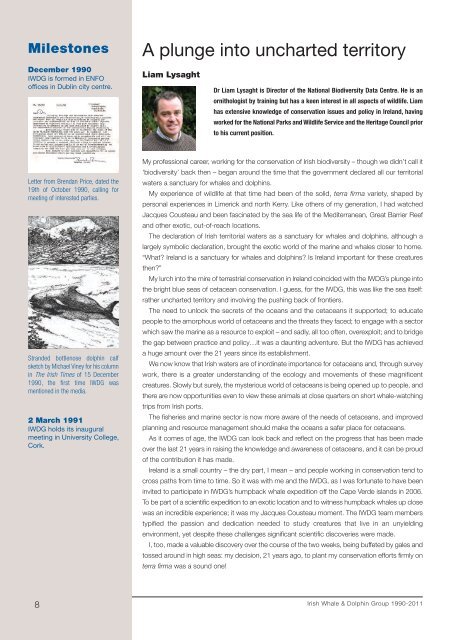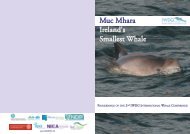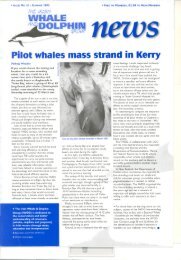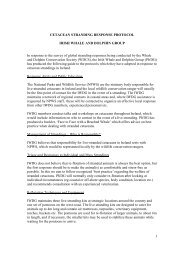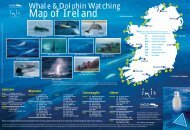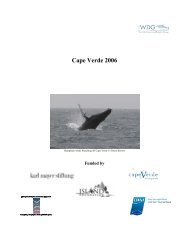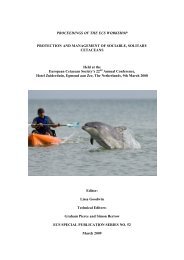published a review - Irish Whale and Dolphin Group
published a review - Irish Whale and Dolphin Group
published a review - Irish Whale and Dolphin Group
Create successful ePaper yourself
Turn your PDF publications into a flip-book with our unique Google optimized e-Paper software.
Milestones<br />
December 1990<br />
IWDG is formed in ENFO<br />
offices in Dublin city centre.<br />
A plunge into uncharted territory<br />
Liam Lysaght<br />
Dr Liam Lysaght is Director of the National Biodiversity Data Centre. He is an<br />
ornithologist by training but has a keen interest in all aspects of wildlife. Liam<br />
has extensive knowledge of conservation issues <strong>and</strong> policy in Irel<strong>and</strong>, having<br />
worked for the National Parks <strong>and</strong> Wildlife Service <strong>and</strong> the Heritage Council prior<br />
to his current position.<br />
Letter from Brendan Price, dated the<br />
19th of October 1990, calling for<br />
meeting of interested parties.<br />
Str<strong>and</strong>ed bottlenose dolphin calf<br />
sketch by Michael Viney for his column<br />
in The <strong>Irish</strong> Times of 15 December<br />
1990, the first time IWDG was<br />
mentioned in the media.<br />
2 March 1991<br />
IWDG holds its inaugural<br />
meeting in University College,<br />
Cork.<br />
My professional career, working for the conservation of <strong>Irish</strong> biodiversity – though we didn’t call it<br />
‘biodiversity’ back then – began around the time that the government declared all our territorial<br />
waters a sanctuary for whales <strong>and</strong> dolphins.<br />
My experience of wildlife at that time had been of the solid, terra firma variety, shaped by<br />
personal experiences in Limerick <strong>and</strong> north Kerry. Like others of my generation, I had watched<br />
Jacques Cousteau <strong>and</strong> been fascinated by the sea life of the Mediterranean, Great Barrier Reef<br />
<strong>and</strong> other exotic, out-of-reach locations.<br />
The declaration of <strong>Irish</strong> territorial waters as a sanctuary for whales <strong>and</strong> dolphins, although a<br />
largely symbolic declaration, brought the exotic world of the marine <strong>and</strong> whales closer to home.<br />
“What? Irel<strong>and</strong> is a sanctuary for whales <strong>and</strong> dolphins? Is Irel<strong>and</strong> important for these creatures<br />
then?”<br />
My lurch into the mire of terrestrial conservation in Irel<strong>and</strong> coincided with the IWDG’s plunge into<br />
the bright blue seas of cetacean conservation. I guess, for the IWDG, this was like the sea itself:<br />
rather uncharted territory <strong>and</strong> involving the pushing back of frontiers.<br />
The need to unlock the secrets of the oceans <strong>and</strong> the cetaceans it supported; to educate<br />
people to the amorphous world of cetaceans <strong>and</strong> the threats they faced; to engage with a sector<br />
which saw the marine as a resource to exploit – <strong>and</strong> sadly, all too often, overexploit; <strong>and</strong> to bridge<br />
the gap between practice <strong>and</strong> policy…it was a daunting adventure. But the IWDG has achieved<br />
a huge amount over the 21 years since its establishment.<br />
We now know that <strong>Irish</strong> waters are of inordinate importance for cetaceans <strong>and</strong>, through survey<br />
work, there is a greater underst<strong>and</strong>ing of the ecology <strong>and</strong> movements of these magnificent<br />
creatures. Slowly but surely, the mysterious world of cetaceans is being opened up to people, <strong>and</strong><br />
there are now opportunities even to view these animals at close quarters on short whale-watching<br />
trips from <strong>Irish</strong> ports.<br />
The fisheries <strong>and</strong> marine sector is now more aware of the needs of cetaceans, <strong>and</strong> improved<br />
planning <strong>and</strong> resource management should make the oceans a safer place for cetaceans.<br />
As it comes of age, the IWDG can look back <strong>and</strong> reflect on the progress that has been made<br />
over the last 21 years in raising the knowledge <strong>and</strong> awareness of cetaceans, <strong>and</strong> it can be proud<br />
of the contribution it has made.<br />
Irel<strong>and</strong> is a small country – the dry part, I mean – <strong>and</strong> people working in conservation tend to<br />
cross paths from time to time. So it was with me <strong>and</strong> the IWDG, as I was fortunate to have been<br />
invited to participate in IWDG’s humpback whale expedition off the Cape Verde isl<strong>and</strong>s in 2006.<br />
To be part of a scientific expedition to an exotic location <strong>and</strong> to witness humpback whales up close<br />
was an incredible experience; it was my Jacques Cousteau moment. The IWDG team members<br />
typified the passion <strong>and</strong> dedication needed to study creatures that live in an unyielding<br />
environment, yet despite these challenges significant scientific discoveries were made.<br />
I, too, made a valuable discovery over the course of the two weeks, being buffeted by gales <strong>and</strong><br />
tossed around in high seas: my decision, 21 years ago, to plant my conservation efforts firmly on<br />
terra firma was a sound one!<br />
8<br />
<strong>Irish</strong> <strong>Whale</strong> & <strong>Dolphin</strong> <strong>Group</strong> 1990-2011


